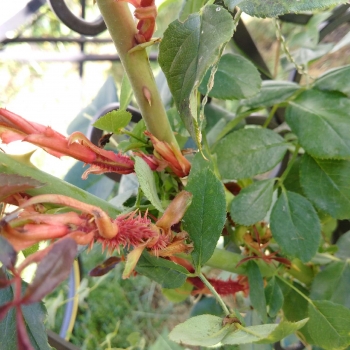
There isn’t much more unpleasant to a gardener than watching helplessly as a young plant develops symptoms of an incurable disease. Last fall, one of my James Galway shrubs started showing telltale signs of RRD (Rose Rosette Disease), a virus (spread my a microscopic mite) that can decimate and disfigure roses. Unfortunately, once you are reasonably sure of the diagnosis, there is nothing that can be done to help the plant — it needs to be removed, before the disease spreads to others nearby.
I’ll be posting more about this topic (in particular because an unrelated, potted plant developed a case of it this year, and likewise also had to be put down). But for now, there are two key symptoms that characterize this condition:
- Markedly disfigured growth, characterized by twisted leaves or canes (often said to appear like a “witch’s broom”)
- Unusually dense (but soft, even almost rubbery) thorns
Note: red growth is commonly seen with RRD but is not a symptom in and of itself. I’ve lost count of the number of times I’ve seen someone freak out in a gardening forum, because a new branch on one of their plants happened to look reddish. The new growth of plenty of cultivars is reddish to begin with — sometimes dramatically so — and changes in weather, fertilizers, etc., can all have an impact on color as well. If you find yourself in this situation, remember you are looking for growth that is unusual to that particular variety. Don’t oversimplify — if one of your plants has contracted RRD, it’s likely going to look really disfigured, not just tinted a different color.
